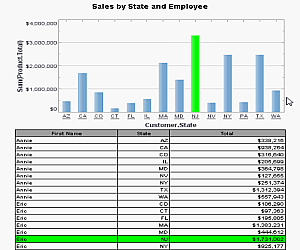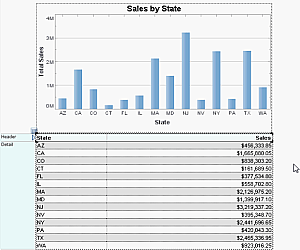Reporting Software Tutorials
More Resources for Industry Reporting
-
Key Industry Performance Measures for
Manufacturing Operations
This article reviews the critical metrics that operations analysts in manufacturing rely on, such as equipment availability, performance, yield and cycle time. It shows how tracking Overall Equipment Effectiveness (OEE) gives a balanced view of uptime, speed and quality in production. The piece explains how throughput and waste metrics combine with machine-level KPIs to drive continuous improvement. It emphasizes that linking these KPIs to a dashboard enables timely insights and better decision making.
-
Selecting Effective Marketing Performance
Indicators
This article outlines 21 best practices for choosing marketing KPIs, including using benchmarks, dashboards and goal-setting. It discusses measuring metrics like conversion rate, cost per acquisition, campaign reach and customer lifetime value. The narrative stresses the importance of aligning KPIs with strategic objectives and not just collecting data for its own sake. It shows how embedding them in visual dashboards improves clarity and accountability across the marketing team.
-
Project Analytics and Performance-Indicator
Sets
This article examines how project analysts use KPIs to monitor scope creep, requirement coverage, cost variance, and schedule performance. It explains how metrics like Schedule Performance Index (SPI) and Cost Performance Index (CPI) support project health assessment. The content emphasizes dashboards as a tool to visualise trends, detect issues early and enable corrective action. It also links project KPIs to overall business goals to ensure alignment and value delivery.
-
Major Performance Measures for Project Analysts
This article delves deeper into KPIs relevant to project operations analysts, such as resource utilisation rate, workload balance, risk exposure, and documentation compliance. It highlights how analytics help track indicators like change request turnaround time, stakeholder feedback rate and defect density. The piece covers how latent issues can be surfaced via trend analysis rather than one-off snapshots. It advocates for a dashboard-first approach to monitor project health continuously and engage stakeholders proactively.
-
Support Desk Service
Metrics and Dashboards
This article reviews the key indicators used in help-desk and customer support dashboards, including ticket resolution time, first response time, CSAT scores and self-service usage. It explains how agent workload, escalation rates and average handling time tie into operational efficiency and customer experience. The content emphasises visual trends and comparative KPIs over raw counts to reveal efficiency gaps. It further shows how embedding these KPIs in real-time dashboards improves both transparency and responsiveness in support operations.
-
Service Level
Monitoring Performance Indicators
This article explores KPIs used in monitoring service-level dashboards such as uptime percentage, downtime duration, mean time between failures (MTBF) and mean time to recover (MTTR). It explains why tracking response time, latency and throughput is critical for service reliability. The narrative also covers incident count, error rate and trend analysis as part of service health monitoring. It argues that presenting these KPIs on dashboards creates an operational “control panel” for proactive service management.
-
Sustainability
and Environmental Performance Indicators
This article addresses how organisations measure sustainability via KPIs such as carbon footprint, energy consumption, waste management metrics and water usage. It describes how analytics associated with these measures support environmental, social and governance (ESG) objectives. The piece emphasises tracking renewable energy integration, social impact indicators and regulatory compliance alongside environmental metrics. It makes the case that dashboards provide the transparency necessary for sustainable transformation.
-
Employee
Benefits Program Effectiveness Indicators
This article discusses how HR and benefits teams track KPIs such as enrollment rates, utilization, cost per employee and satisfaction related to benefits programs. It shows how analytics of these KPIs allow cost control and program optimisation. The piece highlights the need to integrate these indicators into dashboards so that HR professionals can monitor trends and adjust offerings. It also emphasises that clear visualisation of benefits metrics drives better communication and planning in workforce management.
-
Billing Operations Efficiency and
Accuracy Metrics
This article explores KPIs that billing operations analysts track, such as billing accuracy rate, invoice error rate, cash flow, billing and collection efficiency and customer satisfaction. It explains how analytics applied to these metrics guide process improvement and cost reduction. The piece underscores the value of dashboards in linking accuracy-focused KPIs with financial health indicators. It points out that timely dashboards support both operational and strategic perspectives in billing environments.
-
Endpoint Protection Security Metrics and
Indicators
This article reviews critical KPIs in endpoint protection and cybersecurity dashboards, including threat detection rate, incident response time, patch management metrics, compliance rates and user behaviour anomaly detection. It emphasises that analytics on these KPIs support proactive security operations and risk reduction. The narrative also covers how dashboards visualising these indicators aid in spotting emerging threats and resource burdens on endpoints. It argues that presenting these indicators clearly enables IT teams to prioritise actions and show security posture improvement.
-
Capital Program
Management Project KPIs
This article examines KPIs used in capital program management dashboards, including budget variance, earned value analysis (EVA), cost performance index (CPI), schedule performance index (SPI) and risk exposure. It explains how analytics of resource utilisation, schedule adherence and risk mitigation effectiveness provide a full view of project portfolio health. The piece emphasises that operational dashboards enable real-time insight into large capital investments and programs. It suggests that visualising these KPIs helps align stakeholders and supports strategic decision-making across large scale initiatives.
-
Software
Requirements Management Performance Metrics
This article dives into KPIs relevant in requirements management dashboards, such as requirement traceability, coverage, change management turnaround time, review findings and documentation adherence. It emphasises analytics to monitor priority shifts, stakeholder engagement, validation cycle time and defect density in requirements. The piece shows how dashboards bring visibility to evolving requirements and support agile governance. It proposes that tracking these KPIs enables better alignment between business goals and delivery outcomes in software and product development.
-
Wide Range of Dashboard Indicator Sets Across Industries
This article surveys a broad list of KPIs and analytics applicable across many dashboard types and industries, from construction estimating and heavy construction to rail operations, e-commerce and more. It highlights the need for industry-specific indicators like incident severity in emergency services or on-time performance for rail operators. The narrative emphasises the value of adaptable dashboard platforms that support diverse KPI sets without reinventing mechanisms. It encourages selecting KPIs that reflect the business’s processes instead of copying generic metrics.
-
Investment Operations
Analyst Key Performance Indicators
This article explores KPIs used by investment operations analysts such as trade execution speed, fill rate, cost per trade, ROI, risk-adjusted returns, portfolio diversification and compliance metrics. It explains how analytics of settlement cycle, trade errors and STP rate support operational excellence in financial services. The piece also covers tracking liquidity, market share, client retention and tracking error as indicators of fund health. It recommends dashboards for combining transactional, performance and risk KPIs into a unified view.
-
Industry-Specific KPI Resource Collection
This article is a resource collection listing KPIs and metrics across many industries — from cable field service, mobile technicians, rail operators, grocery stores, to city managers and associations. It provides ready-to-use KPI lists such as first-time fix rate, mean time to repair, conversion rate, basket size, utilization rates, member growth and more. The piece illustrates how dashboards enable cross-industry analytics by providing flexible visualisation and data mash-up. It argues that selecting appropriate KPIs is foundational and that BI tools should support diverse datasets and dynamic dashboards.





